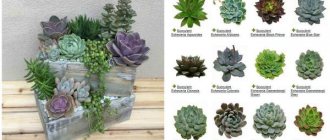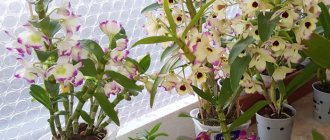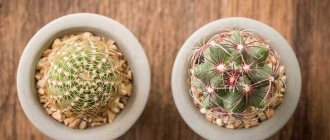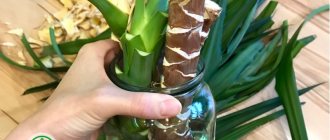Cyclamen is beautiful for everyone: it blooms in winter, when most plants rest, and its inflorescences are unusual, like butterflies on long peduncles.
And this winter beauty is simply a godsend for gardeners who want to get a lot of new bushes. There is nothing complicated or impossible about how to propagate cyclamen. Almost all methods existing in nature are suitable for this culture. It’s just that some of them will give quick results, for example, as when dividing a socket. If you decide to experiment and sow seeds, you will have to wait many times longer. However, let's look at each of them in order so that you have at least a general idea. So, cyclamens can be diluted using:
- seeds;
- leaves;
- dividing an adult tuber;
- sockets (aka horns).
Seedling care
After one month, the first cyclamen loops should appear on the surface.
Care plays a huge role in their further development. After the first shoots appear, the container must be moved to a room with good lighting. There should still be particles of the seed coat remaining on the tops of these sprouts. If the humidity is sufficient, they will fall off on their own. If these scales interfere with seedlings, they can be wrapped in a damp cloth for several hours. After this procedure, the husk will disappear. When 2-4 true leaves appear on young plants, they can be transplanted into separate pots. Typically, 100 ml plastic cups are used for these purposes. Holes must be made at the bottom for drainage. The composition of the soil should be the same as that used for crops. The soil mixture is filled into cups up to half the volume, after which the sprout and tuber are placed and covered with the rest of the soil.
The surface must be carefully crushed, trying not to harm the fragile seedlings. The soil above is watered abundantly
If in 3 months these flowers increase in growth slightly, then do not worry. As a rule, during this period, plants intensively grow only the root system. Grown-up cyclamen are transplanted into a pot with a diameter of about 5 cm. To plant cyclamen in a pot, you can use a universal soil mixture, which is sold in stores for indoor plants. A drainage layer is placed at the bottom, which should occupy a quarter of the entire volume of the pot. The tuber is not completely buried in the soil; about a third of it should be located on the surface.
How to water cyclamen? Watering is carried out through a tray. Thanks to this, you can avoid rotting of the cyclamen tuber.
As for feeding, the first of them is carried out at the age of 6 months. For this, complex mineral fertilizers are used, but the concentration of the solution should be halved.
How to care for seedlings?
For young cyclamen sprouts, it is necessary to ensure an ambient temperature of at least 15°C. As a result of growth at elevated temperatures, the plant hardens. When two seed leaves of a cyclamen sprout, it must be planted in a separate area.
The first movement is carried out 6 months after planting; a violet shoot first emerges from the soil, an ovary forms below, which eventually forms a tuber.
If the gardener sees that the petals cannot free themselves from the seed skin, it must be removed using tweezers. A young flower emerges slowly, since the main energy is given to the growth of the root system. It is recommended to moisten new stems with a pipette at the root, as a result, rotting of the plant is prevented.
Step-by-step disembarkation
Sowing begins with the preparation of the necessary components and the planting material itself.
It is important to follow the instructions so that planting cyclamen seeds at home will end in success. Be sure to select the correct soil and container, as well as process the material
Preparation of material
Preliminary preparation of seeds will help to plant the plant correctly. There are several ways to do this:
- Soaking with Fairy or other dishwashing detergent. Add a few drops of detergent to a container of water and immerse the material. The container should stand for three days, and the liquid should be replaced with fresh one every day.
- Potassium permanganate. To make the solution, several manganese crystals are poured with water at room temperature so that the liquid becomes slightly pinkish in color. The seeds are soaked for about 15 hours.
- The third option involves the use of special preparations that can be purchased at the same flower shop. The instructions for their use are usually found on the packaging.
- And the easiest way is to simply fill the planting material with cold water for a day.
Soil selection
The soil should be light so that it is easier for seedlings to break through. You can purchase it in specialized departments or try mixing it yourself.
Calla lilies in a pot: planting and care at home
If you want to use the second option, then peat, which is combined with leaf humus in a 1:1 ratio, is suitable for this purpose. After which the resulting mixture is sifted, removing dirt and larvae, and disinfected. Again, there are several ways to do this:
Calcination. Can be done in the oven or microwave. The soil is poured onto a baking sheet or into a bowl with low sides and placed in the selected unit. Exposure time is 10−15 minutes. Use of steam. Steaming is also an excellent option; a water bath is suitable in this case.
But it is important to remember that after the procedure the soil should stand for at least a week and only then be used. Treatment with potassium permanganate. Pour a hot solution of manganese into the soil and allow it to dry completely.
Planting process
When starting this stage, the work surface is covered with oilcloth, and gloves are put on your hands, although this is not necessary. For work you will need: a container (it is better to take a square one, not very deep, but wide), soil, water, seeds and a lid for the greenhouse. The process itself is as follows.
- Holes are made in the bottom of the box if they are not provided for in the design.
- The first layer is polystyrene foam or pebbles.
- Next, evenly sprinkle soil on top with a layer of 5-6 cm.
- The soil is moistened with water.
- Seeds are placed on damp soil at a distance of at least 3 cm from each other.
- Soil is again poured on top, but the thickness of the layer should not exceed 1-2 cm.
- The last step is to spray the soil with a spray bottle. This is necessary to moisten the soil, but at the same time not wash it away.
Caring for pelargonium at home
This completes the sowing. All that remains is to cover the box with glass and put it in a cool place.
Reproduction methods
tuber
At home, cyclamen can be propagated by a tuber, even in two ways: either by dividing an existing tuber, or by using daughter formations. It is correct to use the tuber after the plant has completed the flowering process. The formation is removed from the soil, dried and divided into several parts. Each of them must have at least one kidney and full healthy roots. The wounds are treated with ash or crushed activated carbon. Don’t forget about disinfecting the tools you use.
After this, it is enough to plant the pieces in nutritious soil and water them so that the plant has enough moisture, but not in excess. If you overwater the planting material, it will rot. It should be mentioned that when propagating Persian cyclamen by tuber, it should not be completely buried in the ground, but one third should be left above the surface. In addition, it is worth pre-heating the soil mixture and then pouring boiling water over the cuttings.
Cyclamen reproduces by daughter tubers. The step-by-step guide in this case is very simple: just separate the daughter formations and plant them in separate pots. In this case, the substrate should also be nutritious, and irrigation should be plentiful, but not excessive
When performing the procedure, it is important that the entire tuber is covered with soil.
Seeds
It will be possible to propagate the plant by using seeds, but in this case the cyclamen will require long and thoughtful care. The first flowers in this case will sprout only after 1 year, and sometimes even in the third or fourth. The seed is first left for 12 hours in water or in a damp gauze in which a growth enhancer is dissolved. The planting itself is carried out in watered soil, placed in a container with holes in the bottom and drainage in the form of expanded clay. The substrate layer should be 8 centimeters. The seeds should not be deepened - just spread them out so that there is about 4 centimeters between the individual seeds.
Everything is sprinkled on top with a 1 centimeter thick substrate, and the container itself is covered with plastic wrap or covered with glass. When the first shoots hatch, you can remove the shelter to allow the sun's rays to calmly reach the cyclamen. After about 3 months, small tubers will form and full leaves will sprout. Each sprout can be planted in a separate pot, sprinkling soil on the root system. For the first 14 days, the plants are fed with ammonium sulfate, and after another 2 weeks - with potassium sulfur.
Leaves
Propagation by leaves is considered a more complex method. In this case, the leaf blade should already have small roots. Such a shoot is planted in moist soil and covered with a glass jar. Such a leaf has the ability to hatch successfully. However, it should be mentioned that leaves with roots are characteristic only of European cyclamen, and in the case of Persian cyclamen this technique will not work. In addition, most often the leaf, after standing in water, rots at the bottom and dries out at the top. It is still recommended to use this method only for experienced specialists.
Rosettes
The most effective way is considered to be the propagation of cyclamen by rosettes, which are also called horns. This term refers to shoots on tubers. In mature plants, they are usually of sufficient length, so they are easy to break off and plant in damp soil. The container is closed on top with a transparent glass jar or covered with a plastic bag. If the room is maintained at a moderately warm temperature, roots will begin to appear in about 2 weeks. Then the cyclamen can be cared for as a full-fledged adult plant. When choosing this method, you should understand that you should not take more than one horn, otherwise the flower will simply die.
Plant transplantation and propagation
Transfer
Typically, this process is carried out in early autumn or late summer. Around this time, the plant has finally moved away from its dormant state, it is full of vitality and therefore will endure the transplantation process without any problems.
There are only two objective reasons for replanting a plant:
- The bulb has grown so wide that it does not fit in the pot.
- 2 years have passed since the last substrate replacement.
The transplant itself does not pose any particular problems. The plant is cleared of the soil clod (often it is washed under lukewarm water) and planted in a new container. Naturally, it is advisable to change the soil during any replanting, however, if a period of two years has not passed, you can skip this procedure and replant the plants along with a lump of soil using the transshipment method.
Vegetative method
The plant reproduces both by seed and vegetatively
Bush division is used as a vegetative method of propagation. Usually, it is done towards the end of the dormant period, but it can be done as soon as the last leaves of the cyclamen have fallen.
The largest daughter shoots are located on the bulb and it is cut into several parts (usually 2 or 3) on each of which there are 1-2 daughter growth buds. The maternal growth bud must remain with at least one daughter bud. In addition, during the separation process it is extremely undesirable to in any way affect the maternal growth bud.
Dividing a plant bulb
The cut of the onion is smeared with brilliant green and left to dry in the open air. The root system of the plant can either be preserved or completely removed. It is recommended to preserve it, since when a new plant grows from a daughter bulb, it will not need additional nutrients due to the preserved root system.
At the end of the dormant period, the separated tubers of the plants are planted in special soil for seedlings, in which they will spend at least six months in order to restore the root system and heal damage to the tubers. After which they are transplanted into regular soil and stationary pots.
Soil for seedlings may have the following composition:
- humus - 3 parts
- sand - 4 parts
- leaf soil - 3 parts
Similar to soil for adult plants, it must be disinfected.
Seed propagation
Unfortunately, when a cyclamen bulb is divided into several parts, a large percentage of the tubers die. It is possible that all parts of the tubers may die, including even the mother plant.
To avoid such unpleasant excesses, seed cultivation of cyclamen is used. This process is quite complex and painstaking, however, it allows you to avoid the death of your pets from unsuccessful vegetative reproductions.
Cyclamen seeds
In order to begin seed propagation, it is necessary to artificially pollinate the flowers during the flowering period using a special very soft brush. It is advisable to do this several times or over several days.
As soon as flowering ends, do not immediately remove the ovaries - the fruits are not yet ripe. They need to dry naturally. Before the seed box is almost ready to open, you need to remove the seeds from there and soak them for 24 hours in lukewarm water. It is during this period that the seeds will have maximum germination.
After which the seeds are planted in special seedling boxes or pots of very large diameter. The seeds are placed at a fairly large distance from each other (from 5 to 10 cm). After this, they are covered with a 5 mm layer of sand or vermiculite.
Container with cyclamen seedlings
In this case, containers with seedlings are placed in “warm” conditions for cyclamen - temperature +17-20°C and the absence of bright light sources. Their soil is constantly kept moist using a spray bottle. Its use is necessary because with this method of watering the seeds are not washed out of the ground.
The seeds begin to sprout after about a month, but this does not happen at once. The last sprouts to hatch can be observed approximately 2 months after planting the seeds.
Cyclamen seedlings before planting in individual pots
As soon as the first shoots appear, boxes or pots with seedlings are taken out into open sunlight. When the plants have 2-3 true leaves, they are transplanted into individual pots and they begin to care for them like adult plants. The first flowering of cyclamens grown in this way occurs in the second year after planting the seeds.
Methods for propagating cyclamen
Propagation of cyclamen by dividing tubers and subsequent planting of rosettes leads to the fact that young cyclamen will bloom within six months, and with seed propagation - no earlier than a year, but most often flowering occurs after 18 months.
The main condition for success during propagation is the correct selection of the appropriate soil: the better the quality of the soil is chosen, the faster the young plants will take root and develop fully.
The soil mixture for cyclamen must be fertile and loose, and consist of peat, leaf soil and a mixture of humus.
If a ready-made substrate is used for propagation, it must be mixed with steamed garden soil. You need to add a little sand to the soil mixture: this will allow the soil to drain water well and will not compact over time. A drainage layer must be placed at the bottom of the pot so that the roots of the plant receive oxygen and there is no stagnation of moisture.
Propagation of cyclamen by dividing tubers
When and how to divide tubers
By dividing tubers, propagation of cyclamen is usually carried out during the dormant period, that is, after the end of winter flowering, this moment most often occurs at the beginning of spring.
The tuber must be carefully removed from the ground, dried and cut into several pieces with a very sharp knife.
When cutting a tuber, it is important to ensure that each part of the tuber formed has roots and buds.
All sections, in order to avoid any infection, must be treated with activated charcoal or charcoal and dried a little in the shade.
Planting tubers
Tubers are planted in prepared soil in the fall. They cannot be completely buried in the ground; they are laid on the ground, pressed lightly and sprinkled with a little earth on the sides; the upper part of the tuber should be located above the ground.
Features of care
Watering should be regular, but not very abundant, to prevent rotting. Cyclamen can tolerate mild drought much more easily than stagnant water.
Lighting should be diffused.
Any type of cyclamen is a plant that prefers cool weather, so the most optimal temperature for cyclamen is 15-18 degrees; if cyclamen is kept near heating devices during propagation, the plant will die.
When young leaves appear on the tubers, this indicates the normal development of the young plant.
Cyclomen care at home is not particularly difficult, it blooms for a long time and is very beautiful!
How to do this?
- We remove the bulb from the soil.
- Dry the tuber.
- Cut off the onion. It is necessary to divide so that each part of the tuber has one bud and several roots.
- We place the divided onion in a shaded place to dry the cut.
- Sprinkle the cut with activated or charcoal.
- Preparing the container for planting.
- We fill the container with drainage and pre-prepared soil, which you can buy or you can prepare yourself.
- We plant the tuber in the ground and make sure that the soil is always moist.
After this, we place the container with the plant in place with diffused light. In this case, the temperature should be +14…+16 degrees. We regularly water cyclamen .
Rules of care
Lighting
Cyclamen does not like direct sunlight, so it is better to place it on northern, western and eastern windows. In winter, when the amount of light decreases, it can be moved to southwest or southeast windows.
During the dormant period, the pot with the tuber is placed in a shaded, cool room. This can be a shaded place on the balcony or terrace. Some people place a pot with a tuber under the bathtub for the summer. But at the same time, we must not forget to water the soil once or twice a month with a small amount of settled water.
Temperature
When the room temperature is above 17-18 degrees, it is necessary to increase the air humidity. It is not recommended to spray cyclamen. You can spray water into the air around the plant, making sure that the droplets do not fall on the plant. But the best way is to place the pot with cyclamen on wet pebbles or expanded clay. In this case, the pot should not stand in water, otherwise this will lead to rotting of the tubers.
The watering regime for cyclamen is determined by the period of flower development. During the period of leaf appearance and flowering, watering is done more often to prevent the earthen clod from drying out. Watering is carried out with settled water at a temperature a couple of degrees below room temperature. As the leaves begin to wilt, reduce the amount and frequency of watering.
During the dormant period, infrequent watering with a small amount of water is carried out. Water along the edge of the pot to prevent moisture from getting on the tuber. Watering a flowering plant is carried out through a tray, pouring out the remaining water after an hour. You can lower the pot into a container of water for fifteen minutes so that the water does not reach the edge of the pot. This method is suitable for a clay pot whose pores allow water to pass through. A plant in a plastic pot is watered through a tray.
Top dressing
From the moment the leaves appear until the end of the flowering period, cyclamen must be fed. Use complex fertilizers for beautifully flowering plants. Perform two feedings per month. In summer, during the dormant period, cyclamen is not fertilized.
Cyclamen prefers light and loose soil, neutral or slightly acidic. If you prepare the mixture yourself, you need to take leaf and turf soil, peat and sand in equal quantities. Another mixture is also suitable for growing cyclamen:
- leaf soil (3 hours);
- peat (1 tsp);
- sand (1 hour).
Transfer
The plant is replanted after the end of the dormant period, when young leaves begin to emerge. First you need to select a pot according to the size of the tuber.
There should be holes at the bottom of the pot for water drainage. First, a layer of expanded clay is poured. Then an earthen mixture is added, which must be heated in the oven for half an hour before planting to kill bacteria. After all, cyclamen tubers are easily susceptible to disease.
When replanting, it is not recommended to clear a healthy tuber of old soil.
The exception is diseased plants and recently purchased ones. The tubers are inspected for the presence of rot, the rotten parts are cut out, and the cut is sprinkled with crushed activated carbon. Purchased plants are planted in soil with a large amount of peat to accelerate growth. Therefore, you need to transplant the cyclamen into more suitable soil.
Young flowers up to five years old are replanted annually. Adult plants are transferred to a new pot, first once every two years, and then after three years.
Let us pay attention to one subtlety when caring for cyclamen. When the flowers fade and the leaves dry out, they must be removed.
Removing faded flowers lengthens the flowering period, promoting the appearance of new buds. But be sure to perform this procedure correctly. Do not pick or cut off old flower stalks and leaves.
Tuber division
How to plant cyclamen tuber? This question arises among many novice lovers of such plants. The procedure for dividing tubers is quite simple and is carried out after the plant has flowered in winter or summer, depending on the type of cyclamen.
Propagation of cyclamen by tuber
The tuber is removed from the soil, completely dried and cut into small components. The division of the tuber must be done in such a way that each resulting part contains roots and at least one bud. To prevent the formation of various infections, all sections must be treated with ash or activated carbon.
The next stage is planting in moist and nutrient-rich soil. Watering should be done very carefully, as excess moisture will lead to rotting of the tuber.
Features of caring for cyclamen at home
Another name for cyclamen is Alpine violet. The homeland of this flower is the Mediterranean. Many flower growers compare cyclamen to a flock of bright butterflies perched on greenery: its flowers are so beautiful and unusual. Their color can be very diverse: bright scarlet, snow-white, pink, red, crimson, peach, purple. And these are not all shades. It should be noted the variety of flower shapes: large or graceful, miniature. There are always a lot of flower stalks: 10-15.
Temperature
First you need to choose a suitable room. It cannot be said that this flower is very whimsical, but it needs ventilated rooms that are well lit. The temperature can be quite cool: +12-15 C, but there should be no drafts. In cooler temperatures, flowering even lasts longer. Cyclamen prefers nutritious and loose soil. You should not purchase a pot that is too large, since cyclamen is a small indoor plant. You need to plant the flower in a mixture of turf, leaf, humus soil and sand. The ratio is: 2:1:1:1.
Watering
The flower needs good and regular watering, but stagnation of moisture is undesirable. It’s great if the pot has a tray, then you should water it into it. This will prevent water from getting to the top of the tuber. Cyclamen loves a humid atmosphere, so it can be sprayed with plain water from all sides. But this should not be done during the flowering period. Proper watering is especially important during the growth period. Water should only be used that is warm and settled. This is necessary to keep the flower healthy.
Fertilizers
Fertilize cyclamen during the flowering period twice a month. To do this, use various types of liquid flower fertilizers. The concentration is as follows: 0.5 caps per two liters of water. The water should be warm and settled. Try to fertilize so that the liquid does not get on the flowers and leaves. You can use a fertilizer called “Floretta” for feeding.
It is very important to fertilize with chlorine-free fertilizer. Cyclamen does not welcome an excess of mineral salts, so mineral fertilizers must be applied in small quantities
Fertilizing is carried out in this way: you must first water the soil and wait until it is saturated, then you can fertilize it.
When planting on your own, it is not recommended to feed the flower before the first shoots appear. A young plant or one that has just been transplanted does not need additional feeding for six months. Fertilizers should only be applied when the plant is healthy.
What needs to be done after germination
The timing of the appearance of the first shoots depends on the variety of cyclamen chosen and can range from 1 month to six months. Subsequently, seedlings of any variety are characterized by slow growth, which is associated with the growth of tubers. This process may take approximately 3 months. During the period of active growth of seedlings, it is important to regularly spray the soil in the pot and ventilate the planting.
A sprout with a pair of leaves should form from weak petal loops. When it gets stronger, fully opened, it’s time to pick. A young crop needs moisture and coolness, so do not forget about frequent watering and ventilation. In six months, it will become important to feed the seedlings with any fertilizers for flowering crops.
Did you know? Bioenergeticists believe that cyclamen feed on negative energy, and in return give a positive charge. That is why they are advised to grow them in every home.
Possible problems
If the leaves of young cyclamen begin to turn yellow, the cause may be both high temperature in the apartment and dry air. Often the reasons are combined. To prevent this situation, containers with plantings should be placed on window sills, under which there are no batteries, and regular spraying should be carried out. Alternatively, the pots can be placed on a tray filled with constantly moistened pebbles. To quickly correct the situation, cyclamen will have to be immediately removed from the battery, moved to a room where the temperature does not exceed +18 degrees, and spraying should also begin.
When the flowers are healthy, but the leaves still turn yellow, the problem may be excessively high temperatures. By returning the readings to +18 degrees, it will be possible to eliminate the problem. Sometimes leaf blades turn yellow due to the fact that the substrate is not sufficiently moistened. It is clear that in this case it is enough to simply increase watering frequency. Finally, the leaves may turn yellow and fall off after the cyclamen blooms, which is an absolutely natural phenomenon. This phenomenon suggests that the plant is simply adjusting to a state of rest. If the leaf shedding is too intense, it is better to move the plantings to other rooms.
When the root system begins to rot, the problem may lie not only in excess liquid, but also in the fact that it pours directly onto the top of the tuber - its rosette. Otherwise, the core of the flower not only rots, but also becomes moldy. If cyclamen leaves begin to deform, this may indicate pest attack. The miniature cyclamen mite cannot be seen on the surface of the leaf blade, but its impact leads to curling of the leaf edges and cessation of their development. In such a situation, the damaged parts of the plant should be immediately eliminated, and then all plantings should be treated with insecticides.
Gray mold occurs when the plant is kept in high humidity and the temperature remains too cold. As preventive measures, experts advise regularly ventilating the room and keeping the temperature at +18 degrees.
You will learn more about propagating cyclamen at home in the following video.
Peculiarities
Cyclamen has more than 20 varieties within its genus. The differences between them are that each species has its own color or differs from its counterpart in the structure of the flower - there are even flowers with a double structure. In addition, the size of the flower also varies depending on the type of plant: this exotic beauty grows from 15 to 30-35 centimeters in height.
Cyclamen is a perennial; all its modern varietal hybrids were obtained from Persian and European cyclamen species. These are the species that experts recommend for home breeding.
With proper care, Persian cyclamen can grow up to 30 cm in height. Outwardly, it is very attractive, it has dark green leaves with a light green edging, and large flowers have rich pink shades.
European cyclamen also has dark green leaves, but the pattern on them is not as contrasting as that of the Persian species. The flowers of the European variety are smaller in size, but they are much brighter in color. European cyclamen has a peculiarity - it does not have a winter dormant phase, which means it will be much easier to care for.
The root system of cyclamen is tuberous; there are dormant buds on it, from which leaves sprout, collecting in a rosette. In the center of the tuber there are growth points for future flower stalks. Growing up, these flower stalks rise above the foliage. Flowers on peduncles grow with a downward slope, and their petals bend upward. Each flower has both a pistil and a stamen, that is, it is a hermaphrodite.
When to replant cyclamen
The plant can be replanted in the period after the flowers fall and before the next buds begin to form. An annual transplant is needed to renew the flower and stimulate the growing season.
The vegetative year of a flower should be divided into a period of dormancy and flowering. During hibernation, fertilizers are not applied to crops, watering is minimal, and the air temperature in the room is increased. This is a good time to replant the plant, as it is less susceptible to stress.
Note! Over time, the soil becomes depleted and the crop does not receive enough nutrients. By external manifestations you can understand when you can replant cyclamen
If, under the right conditions, the bush does not bloom for a long time and begins to dry out and the leaves turn yellow, you need to check it for pests. The above-ground part is carefully inspected. If the leaves are clean, you need to check the condition of the roots. The tuber may be affected by rot or insects. In this case, they are treated with an insecticide, the damaged roots are removed, and the tuber is transplanted into a new pot. In this case, flower growers recommend completely replacing the soil.
An adult plant may not fit in an old container. You should pull out the root and see how much space it takes up in the pot. If there is no more room left for the development of the tuber, transplantation into a new, more spacious pot is required.
Is it possible to replant a flowering plant?
It is not recommended to replant any crop during the flowering period. The plant devotes a lot of energy to the formation of buds, the opening of flowers, and the formation of seeds. Transplanting a blooming cyclamen will cause the buds to dry out, the flowers to fall off, and the adaptation process will be delayed. The next flowering will have to wait a long time.
For your information! Often the bush dies, since replanting during the growing season is stressful.
There are cases when it is necessary to replant cyclamen during the flowering period. These bushes are forced out for sale in a blooming state. When purchased, the bush inevitably dies after the petals fall. But he can be saved in time. In such cases, an emergency transplant of flowering cyclamen is done.
Flowering purple variety
First of all, all the buds and flowers are cut off and the bush is transplanted into new soil. The substrate should not be fertilized. It is best to plant the flower in depleted soil; you can add more sand. The culture is put into a dormant state, transferred to a cold place, watered little and not fed.
How to transplant cyclamen at home is described step by step in the next section.
Pests and diseases of cyclomen
With proper care, cyclamens can be considered relatively hardy indoor plants. Various diseases can occur due to excessive humidity or dryness of the air in the room, as well as inappropriate temperature. Very often, the development of the disease is facilitated by waterlogging or compaction of the soil, which impedes drainage. Excess, as well as deficiency, of nutrients leads to disruption of biochemical processes in the flower. Another important factor for successfully growing alpine violets is the availability of high-quality substrate. Incorrectly selected or contaminated soil is the cause of many diseases. Flowers are most susceptible to fungal disease - anthracnose (sedip), as well as wet and gray rot.
In nature, there are many pests that can harm cyclamen. The most dangerous and common include thrips, cyclomene and spider mites, and aphids. You can get rid of these pests by removing the affected shoots and using insecticides (Neoron, Fitoverm). Many gardeners spray sick plants with folk remedies. The most popular and effective are soap solution and garlic infusion.
Types of cyclamens
There are countless types of cyclamens. But there are only nine most common types, we will talk about them further. The homeland of this flower is the Mediterranean coast. Due to the rapid spread of the plant, the name of its varieties began to be assigned according to the place of growth, for example: Persian, European, African, etc.
- Persian cyclamen. The most popular type of this plant. It has many varieties. The most popular subspecies are “Barbadosa”, “Gabi” and “Orpheus”. The leaves of the Persian cyclamen are heart-shaped, rich green in color, and have a white marble-like pattern. The petals of the plant come in different colors: from white to purple. There is a hybrid of Persian cyclamen. It has a longer flowering period and comes in eighteen petal colors, unlike the common Persian drake.
- European trash. European cyclamen is also called blushing. Distributed in Italy, Macedonia, Slovenia. The leaves of the flower are basal, with a pointed tip and slightly jagged edges, and have a green-silver color.
- African cyclamen. Algeria and Tunisia are considered to be the birthplace of African cyclamen. There are two types of African cyclamen: tetraploid and diploid. They are distinguished by the smaller caliber of the leaves and the greater fragrant inflorescence of the diploid one.
- Alpine cyclamen. A distinctive feature of this variety of dryer is the special arrangement of the flower petals and their twisted oval shape. The usual arrangement of petals corresponds to 180º, for the alpine violet - 90º.
- Pontic cyclamen. Also known as “Colchisian”, “Abkhazian”, “Caucasian” cyclamen. This type of dryer is used for medicinal purposes and in bouquets. It is listed in the Red Book; unfortunately, there are too few representatives of this species left.
- Greek trash. Grows in damp places with light shade. The leaf color ranges between lime and dark green, and the flower color varies between pale and scarlet pink. In the 80s of the last century, a very rare subspecies of cyclamen with snow-white flowers was found in the Peloponnese, which is now listed in the Red Book.
- Kos cyclamen. As you already understand from the name, this cyclamen was bred on the island of Kos in the Aegean Sea. The base of the petals of this species is very bright, although this drake does not differ in the variety of petal colors from other cyclamens. But colors such as purple, red, white, pink are observed, they are more saturated and bright than other cyclamens.
- Cyprian Drunk. Loves bushy terrain with rocky soil and trees. The height of the plant is 8-16 cm. The leaves have a heart-shaped appearance, the color of the inflorescences is dominated by purple and pink shades.
- Ivy leaf cyclamen. Ivy-leaved cyclamen, or Neapolitan, is the most common plant in Europe. The original name of the flower, Cyclamen hederifolium, was given in 1789. The second, familiar to us - Neapolitan cyclamen - appeared in 1813. This type of dryer is the most frost-resistant, so it gets along well in the northernmost regions of Europe.
What kind of plant is this?
Cyclamen is a perennial herbaceous plant from the Myrsinaceae family. It stands out for its bright and abundant flowering. Its inflorescences resemble a butterfly. They are located on long legs and rise above the foliage, forming a lush flower cap. The flowers come in a variety of colors, from pink to purple. The leaves, which form a dense basal rosette, look like small hearts, painted green with a silver pattern. They are located on petioles of a light green hue.
In nature, this plant lives in difficult climatic conditions, with low temperatures and unstable humidity.
Cyclamen can live up to 25 years, this happens due to the fact that the periods of rest and wakefulness change. In apartment conditions, these flowers live an order of magnitude shorter, since dry and warm air quickly depletes their tubers.
Characteristics
Before delving into the intricacies of how to care for a cyclamen flower, it’s worth learning more about it. A representative of the Myrsinaceae family, it is a perennial herbaceous tuberous plant. Under natural conditions, it grows in the warm, humid climates of the Middle East and Southern Europe. Even on the Black Sea coast you can find blooming cyclamen thickets. The culture includes more than 60 species, and 20 of them have taken root in our country. True, they do not grow in open ground, but in apartment conditions. The Russian winter is too harsh for a heat-loving plant.
The root system of cyclamen is a large tuber, similar to a flattened brown ball. In it, the flower stores moisture, without which it cannot survive, especially in the wild. The diameter of the tuber is on average about 5 cm, but there are real giants. Their simply huge tubers reach 15 cm in diameter.
Numerous thin auxiliary roots grow from the lower part of the tuber. And in the upper part there are growth points. From them, at the beginning of the growing season, leaves appear on long petioles. They have a very beautiful heart-shaped shape with a jagged edge. The main color is green, but the entire surface of the leaf blades is painted with silver strokes.
With the arrival of autumn, thin flower stalks begin to rise one by one above the lush foliage rosette. They bend gracefully under the weight of large flowers. Their elongated wavy petals are bent in the opposite direction, resembling the wings of a butterfly. Each lives for almost 2 weeks, and just one bush can produce up to a hundred buds. The natural color of cyclamen is pink-purple. But breeders have developed many varieties with a wider range of colors.
After flowering ends, the above-ground part of the bush dies off, and the cyclamen goes into hibernation. Only after resting will it be able to bloom again next season.
Preparatory work
Before starting the cyclamen propagation procedure, a number of preparatory work should be carried out:
- Choosing a pot . The plant does not need a container that is too deep, since the roots are not able to completely fill a large space, as a result of which growth slows down. The best option for the culture would be a flat pot, shaped like a soup bowl or bowl. Ideally, the new container should be 2–3 cm larger in diameter than the old one. The material of the pot is not particularly important. There must be holes for drainage.
- The soil . To plant a flower, you can use special soil intended for cyclamen, or prepare the soil yourself. Before use, the soil should be sterilized by any available method: heated in the oven for 10–15 minutes at a temperature of +180...+200°C, poured with a solution of potassium permanganate and dried thoroughly, frozen on the balcony or in the freezer.
- Sterilization of instruments . It is imperative that all tools that will be used during the plant propagation procedure must be disinfected. To do this, they are treated with special purchased disinfectants, wiped with an alcohol solution or soaked for several minutes in a solution of potassium permanganate.
Video: The intricacies of growing cyclamen
Replanting cyclamen
Cyclamens are replanted in the spring. The flower is difficult to tolerate the procedure, so the root is transferred along with a lump of earth. You should not do a transplant more than once every four years. Do not touch the plant during the formation of buds and immediate dissolution.
Prepare the planting soil in advance, mix peat, humus, sand and leaf soil. Take all ingredients in equal proportions. Before transplanting, heat the composition in an oven or pour in a manganese solution.
If you keep an old pot, disinfect it. Do not take the new one too large so that moisture does not stagnate in the soil. There must be drainage holes at the bottom. The plant itself does not need preparation. A sign of its readiness for relocation will be the appearance of small leaves on the tuber after the dormant stage. This happens in the middle of summer.
Transfer rules
The procedure for transplanting a flower is simple. Follow a number of basic rules:
- Place drainage at the bottom of the pot: small pebbles, expanded clay or brick chips.
- Fill the container with the prepared substrate, but not to the very edges.
- Remove the plant from the old soil and lightly shake off the roots.
- Inspect the root system for rot. If there is one, cut off the affected areas and treat with crushed coal.
- Place the tuber in the center, carefully spread the roots throughout the volume. Fill the voids with the remaining soil, leaving the top of the root head exposed.
It is important not to injure weak radicular processes in the process. This will prevent the flower from quickly adapting to a new location.
After all the manipulations, water the cyclamen step by step. Wait until the water is completely absorbed into the soil, only then add a new portion. Then add the slightly settled soil mixture.
It is important to leave the top of the head slightly open. Place the pot in a bright place, but not in the sun
The first month after transplantation is very important. If you violate the basic rules of care, the plant will not take root and will die. Water moderately, without causing stagnation. Dampness leads to the development of putrefactive phenomena. Apply fertilizing after complete adaptation.











